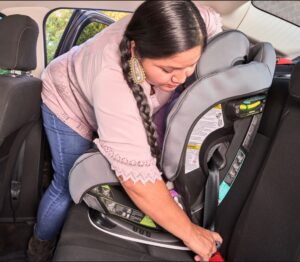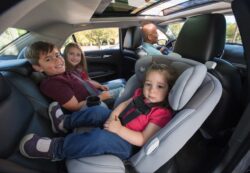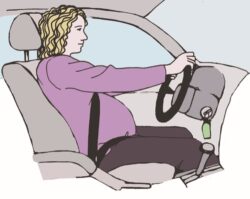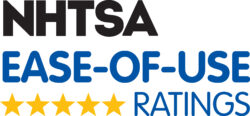A 2024 Kidz in Motion Conference session titled CPS Outreach Strategies and Resources for Tribal Nations and Spanish-Speaking Communities provided important information for any CPS program.
Read More from “Strategies for Reaching AI/AN and Spanish-Speaking Caregivers”News
Blue Bird Raises the Bar for School Bus Safety
In a first for the school bus industry, bus maker Blue Bird Corporation has announced that, starting this year, lap-shoulder seat belts will be standard equipment for all seating positions on all of the company’s school buses.
Read More from “Blue Bird Raises the Bar for School Bus Safety”Ask Katrina: “What Is This—and Why Does It Always Interfere With CR Installation?”
In this regular column, SRN shares vehicle-related information from Katrina Rose, SRN collaborator and vehicle liaison for the LATCH Manual. For this issue, Katrina shares answers to a question many CPSTs have wondered about regarding vehicle seat belts.
Read More from “Ask Katrina: “What Is This—and Why Does It Always Interfere With CR Installation?””Hot Topic: Rear-Facing CRs Touching Seatbacks in Front of Them
As CPSTs know, following CR instructions is essential. A few other considerations are equally important, including following the vehicle instructions and addressing the safety needs of all passengers. Whenever CR instructions intersect with these other considerations, CPSTs must carefully consider all aspects when advising caregivers. “Seatback touching” is such a situation, so this article looks at some of the related considerations.
Read More from “Hot Topic: Rear-Facing CRs Touching Seatbacks in Front of Them”2023-2024 LATCH Manual Update
What to Know About Under-CR Mats and Towels
A caregiver recently emailed SRN the following question:
Now that our kiddo can walk, I am thinking about buying one of those seat mats for our car to protect the upholstery from muddy shoes. I’ve seen friends use them, but are they safe?
CPSTs: Gear Up to Explain Why Coats and CRs Don’t Mix
Adapted from a SRN article published in Fall 2020
As CPSTs know, the transition to winter wear presents an annual challenge to properly using CR harnesses.
Read More from “CPSTs: Gear Up to Explain Why Coats and CRs Don’t Mix”Free Resources to Promote Maternal and Fetal Safety
At the Kidz in Motion conference, SRN was happy to learn about the Hudson Center for Prenatal Vehicle Safety (HCPVS), a nonprofit program of the UCHealth healthcare system based in Fort Collins, Colorado. HCPVS offers free materials to protect pregnant drivers, pregnant passengers, and unborn babies. Gregory Colton, the organization’s founder, staffed an exhibit booth and was also a presenter for a workshop titled “Seat Belt Use During Pregnancy: Improving Community Education.”
Read More from “Free Resources to Promote Maternal and Fetal Safety”Study Examines NHTSA’s CR Ease-of-Use Ratings
Besides regulating vehicles and CRs through Federal Motor Vehicle Safety Standards, NHTSA also influences roadway safety through its various ratings programs, which can be found here.
Read More from “Study Examines NHTSA’s CR Ease-of-Use Ratings”Editorial: Impaired Driving Is a CPS Issue
As most people know, impaired drivers (drunk or high) are a menace on our roadways. What is less recognized, however, is that most (57%) of the children who die in impaired-driver crashes are passengers of the impaired driver. Unsurprisingly, studies show that children riding with an impaired driver are less likely to be properly restrained, and restraint use decreases with increasing child age and driver blood alcohol content. And, since the driver survives 71% of these crashes, many children who perish would likely survive if properly restrained.
Read More from “Editorial: Impaired Driving Is a CPS Issue”






